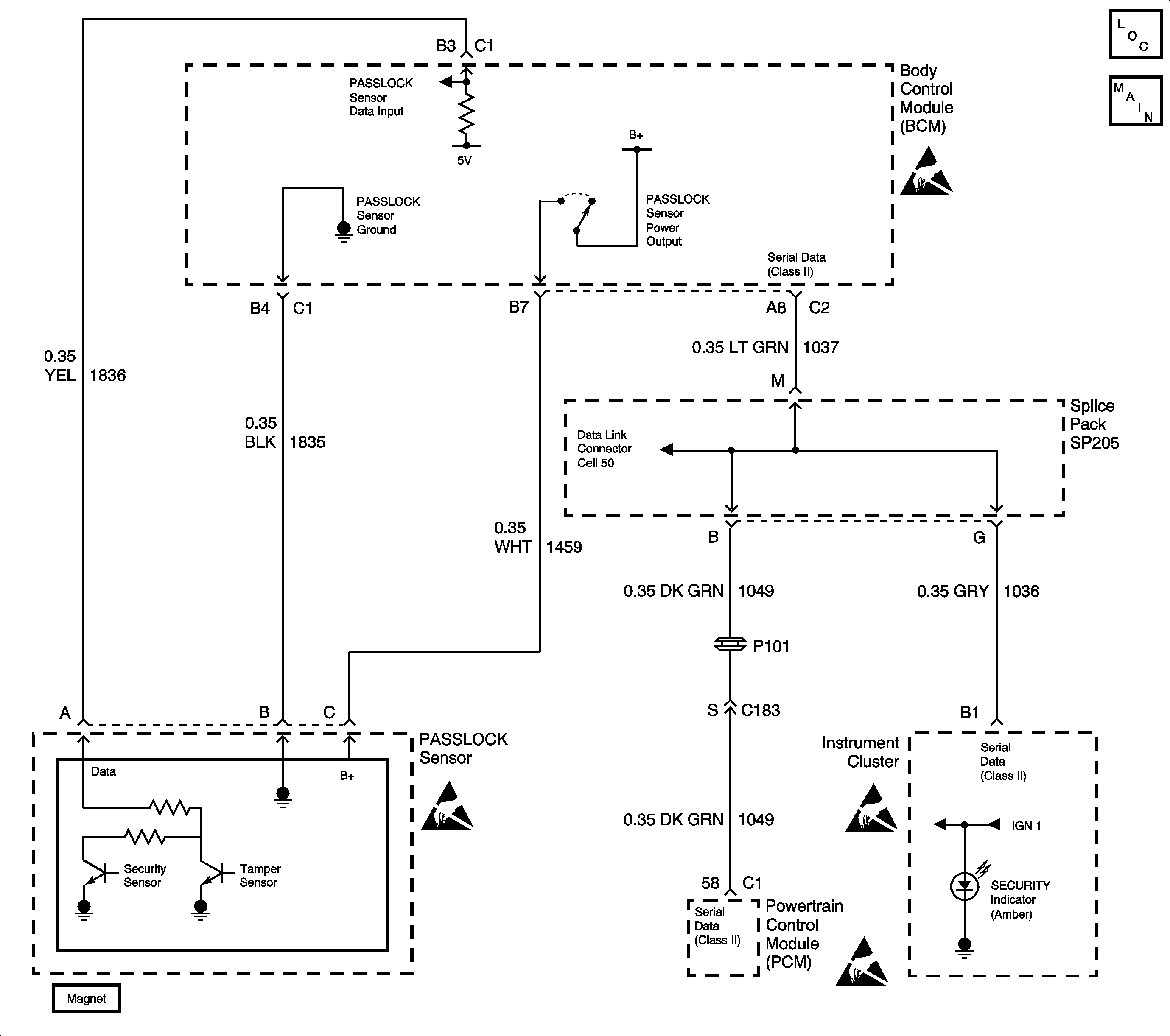
Circuit Description
The Passlock theft deterrent system contains a Passlock sensor. The Passlock sensor is part of the ignition lock cylinder assembly. The Body Control Module (BCM) provides voltage (B+) to the Passlock sensor through circuit 1459 when the ignition switch is in the accessory, on, or start. The BCM also provides ground to the Passlock sensor through circuit 1835. The Passlock sensor interfaces with the BCM through the Passlock detection circuit 1836.
When turning the ignition switch to the start position with the proper key, the Passlock sensor generates an analog voltage signal. This signal is sent through the Passlock detecting circuit. This analog voltage signal is of a specific value to the vehicle, and varies from vehicle to vehicle. When attempting to start the engine, the BCM compares a preset stored analog voltage value with the signal coming from the sensor. Because both values match, the BCM sends a fuel enable password via the Class II serial data link to the Powertrain Control Module (PCM). As a result, the PCM enables the crank relay, and allows fuel delivery to the engine.
When attempting to start the engine by means other than using the proper key in the ignition switch, the Passlock sensor sends an analog voltage signal of a different value. The BCM compares the preset stored analog voltage value with the signal coming from the sensor. Because both values do not match, the BCM sends a fuel disable password via the Class II serial data link to the Powertrain Control Module (PCM). As a result, the PCM disables the crank relay, and stops fuel delivery to the engine.
Conditions for Setting the DTC
| • | The BCM detects a short to ground in circuit 1836. |
| • | Condition must be present during an engine start attempt, or for one second anytime after the engine has started. |
Action Taken When the DTC Sets
| • | The BCM stores DTC B2722 in memory. |
| • | The BCM sends a message to the instrument cluster to flash the SECURITY indicator. |
| • | In addition, the BCM will take one of two actions: |
| 1. | If circuit 1836 is shorted to ground when attempting to start the engine, the BCM does not sends a message to the PCM via Class II serial data link to enable the crank relay, and to deliver fuel delivery to the engine. The vehicle will exhibit an engine no crank condition, OR |
| 2. | If circuit 1836 is shorted to ground after the engine has started, the BCM enters fail-enable mode. Upon subsequent engine start attempts, the BCM will send a message to the PCM via Class II serial data link to enable the crank relay, and to deliver fuel to the engine. The engine will start. |
Conditions for Clearing the DTC
| • | A current DTC B2722 clears when the BCM detects a valid Passlock sensor analog voltage signal on the Passlock detection circuit 1836. |
| • | A history DTC will clear after 100 consecutive ignition cycles if the condition for the malfunction is no longer present. |
| • | Using a scan tool. |
Diagnostic Aids
| • | Check for a short between circuits 1835 and 1836. |
| • | Check for a short to ground in circuit 1836. |
| • | If circuit 1836 is shorted to ground intermittently, the BCM prevents the engine from cranking or starting for a period of ten minutes. |
| • | DTC B2723 may set in the BCM when the ignition switch is on with the Passlock sensor electrical connector disconnected. When BCM diagnostics and repairs are completed for DTC B2722, clear BCM DTCs and perform the BCM Diagnostic System Check. Refer to Diagnostic System Check - Body Control System for procedure. |
| • | DTC P1626 will set in the Powertrain Control Module (PCM) when the ignition switch is on with the Body Control Module (BCM) disconnected. When BCM diagnostics and repairs are completed, refer to Powertrain On Board Diagnostic (OBD) System Check (LX5) or Powertrain On Board Diagnostic (OBD) System Check (L36) in Engine Controls for additional information on PCM related DTCs. |
Test Description
The number(s) below refer to the step number(s) on the diagnostic table.
-
Always perform the BCM diagnostic system check before attempting to diagnose this DTC.
-
Checks for circuits 1835 and 1836 shorted together.
-
Checks for a short to ground in circuit 1836.
-
Checks for 5V pull-up voltage output from the BCM in circuit 1836.
-
Checks for a faulty PASSLOCK sensor that is internally shorted.
Step | Action | Value(s) | Yes | No |
|---|---|---|---|---|
Was the BCM diagnostic system check performed? | -- | |||
Is the measured resistance same as the specified range? | Greater than 1000Kohms | |||
Using a DMM, measure the resistance between the BCM harness connector C1 terminal D2 and ground. Is the resistance measured same as the specified range? | ∞ | |||
Is the voltage measured within the specified range? | 4.5-5.5V | |||
Is the resistance measured same as the specified range? | ∞ | |||
6 | Repair short between circuits 1835 and 1836. Is the repair complete? | -- | -- | |
7 | Repair short to ground in circuit 1836. Is the repair complete? | -- | -- | |
8 |
Is the repair complete? | -- | -- | |
9 |
Is the repair complete? | -- | -- | |
10 |
Are there any current BCM DTCs present? | -- | System OK |
